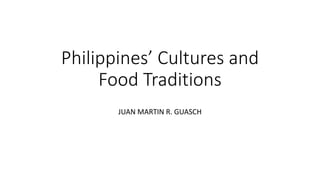
Philippine culture and foods 2019
- 1. Philippines’ Cultures and Food Traditions JUAN MARTIN R. GUASCH
- 3. Objectives: Through this event, students would be able to: 1. Promote our own. 2. Familiarize themselves with different Cultures being practiced in the Philippines that would help them in understanding Heritage and Cultural Tourism. 3. Discover Local Cuisines that would encourage continuous learning of culinary, and food and beverages. This also shows support to the Department of Tourism’s Initiative to promote Culinary Tourism in the Philippines. 4. Share their insights and realization about the differences of Cultures and Cuisines in each region. 5. Learn through an OBE approach.
- 4. Basic Things We need to know about Food and Cooking
- 5. Why do we eat?
- 6. Because WE ARE HUNGRY
- 7. Because of the TASTE
- 8. Because NUTRITIONAL VALUE or because of our HEALTH
- 9. COOKING CUISINE DISH From Middle English “cook” From Latin “coquus” It has a very direct origin from the Latin word for kitchen or cookstove: culina. Culina itself derived from the Latin word coquere, meaning “to cook.” Old English disc "plate, bowl, platter," from Latin discus "dish, platter, quoit," in Medieval Latin "a table, dais, desk, pulpit," from Greek diskos "disk, platter" Is the ART, TECHNOLOGY, SCIENCE and CRAFT of preparing FOOD for CONSUMPTION Is a style of COOKING characterized by distinctive ingredients, techniques Is a specific food preparation A distinct article or variety of food Ready to eat or be served Transforming raw food by way of direct or indirect heat transference or chemical reaction Asian Cuisine African cuisine European cuisine Cuisines of the Americas A dish may be served on tableware or may be eaten out of hand Instructions for preparing a dish are called RECIPES
- 10. Components of Cooking The Technique Skills Ingredients Tradition
- 11. Common Trends in Cooking • TRADITIONAL • FUSION OR ENCULTURATION • DECONSTRUCTIVE • MOLECULIST
- 12. Traditional “We work on what We have”
- 13. Fusion Technique
- 16. Deconstructive This gastronomic concept involves changing the appearance of the various ingredients used in a dish, but preserving and even reinforcing the intensity of their flavors. To do this, each of the components is treated separately, changing and transforming presentation, textures and forms, and playing with temperatures.
- 18. The Philippines •Short history •3 major islands: Luzon Visayas Mindanao •Characteristic of the Philippines •Language •History •Religion
- 26. Types of Events • Corporate Events • Sports Events • Socio-cultural events • Historical events • Life Cycle events • Religious events
- 27. The Filipino family is very important. When you are in the Philippines, you will notice how Filipino families stick together
- 28. Ysabel Padilla y Cruz
- 29. VICENTE SR. GUASCH Y RUIZ
- 32. VICENTE PADILLA GUASCH II 1921 @ UST
- 34. WHEN I WAS IN HIGH SCHOOL 1983
- 37. BUHAY SA SOFITEL
- 40. PCGA
- 43. Guasch’s Family Food Traditions
- 44. Espesyal na Luto ng Tatay ko Bacalao (Stewed Cod Fish) Paboritong Luto ng Nanay ko Pinakbet
- 45. Araw araw na kainan
- 46. Pilipinong Almusal ang mga “silogs”
- 47. Ang Mga Adobo
- 48. Ang Arosep (sea grapes) Ang Pako (edible fern)
- 49. Ang mga Merienda
- 50. Ang Hapunan
- 51. STEW vs SOUP STEW SOUP Complete meal, may be the entree Starters, separate from the entree LESS LIQUID WELL COVERED WITH WATER OR STOCK is a combination of larger-cut ingredients like vegetables, meat, or fish that are just barely covered with cooking liquid, and simmered over low heat for a lengthier period of time It’s made with a combination of ingredients like vegetables, meat, or fish that are well-covered with water or stock, brought to a boil, and then simmered to extract flavor During cooking the liquid reduces into a gravy that is served with the solid ingredients, which are the main focus of the meal is that liquid is the main component of this dish, whether it’s a brothy, creamy, or puréed soup
- 52. Iba’t Ibang STEW • Menudo Sarciado • Afritada (Chicken Cacciatore) Callos • Mechado Tinola • Puchero Sinigang • Kaldereta Bacalao • Kare-kare • Escabeche • Lengua estofada • Pesa
- 55. Ang mga sinigang Sinigang na baboy (Sauteed Pork in Tamarind Soup) Sinigang na bangus sa miso (milkfish in sour miso soup) Sinigang sa bayabas In guava fruit soup
- 56. Tinolang Manok (Chicken in Ginger Broth) Pesa Tinolang Isda (Fish in Ginger Soup)
- 57. Birthday Pambata at Pangmatanda
- 60. Ibang lebel na pagkaing Pinoy
- 61. Kilawing KambingRoasted Goat in vinegar and ginger
- 62. Papaitan Beef Bile Soup Bitter Goat Stew Dinuguan Pork Blood Stew
- 63. Adobong Kamaru
- 64. P P R A I L T A O K N A G
- 65. Mga pagkain pang espesyal na okasyon •SEMANA SANTA •PASKO •BAGONG TAON •FIESTA
- 66. AAAAAAH ‘Di ko na kaya Gutom na ako!
- 67. Thank you South Mansfield College Thank you Mr. Jerwin Derilo and Thank you Mark Gabriel Aguilar!
- 68. References • https://traveltips.usatoday.com/food-culture-philippines-17408.html • https://nomadicboys.com/famous-foods-philippines/ • https://primer.com.ph/blog/2017/03/27/watch-filipino-food-culture- at-flavors-of-the-philippines-2017/ • https://balitangamerica.tv/feastibal-celebrates-philippine-innovative- and-traditional-cuisine-featuring-known-filipino-chefs/ • https://prezi.com/2r3-7an2vsyb/filipino-cultural-food/ • https://www.thespruceeats.com/filipino-cooking-and-culture- 3030285
